When it comes to saints and souls, the Catholic Church has it all over any other human institution for sheer drama. Saints’ relics are a big part of that.
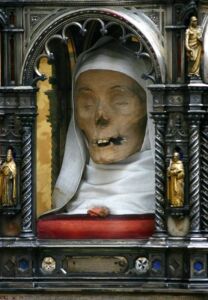 How else do we explain, for example, the fact that St. Catherine of Siena’s head (with the leathery skin still attached) and her forefinger (only that one finger) are on display at the Dominican church in Siena, Italy, while the rest her body lies in a glass case in a church in Rome?
How else do we explain, for example, the fact that St. Catherine of Siena’s head (with the leathery skin still attached) and her forefinger (only that one finger) are on display at the Dominican church in Siena, Italy, while the rest her body lies in a glass case in a church in Rome?
This is not to count, of course, those elements of her body that were sliced into little pieces and doled out in reliquaries for the veneration of the faithful: skin, hair, bits of bone, etc. And there is even an unconfirmed rumor that some of the bone parts are actually kidney stones.
That’s macabre humor at its finest, and if you know anything about the Italians, you know that they don’t take their religion too seriously. In fairness, however, they do seem to take the salvation of souls seriously, which is a good thing.
The Bone Church
Case in point: if you walk into the Capuchin Church on Via Veneto in Rome, you may get the shock of your life. It’s full of bones. It is named for the Immaculate Conception, but the colloquial name for it is, not surprisingly, “The Bone Church”.
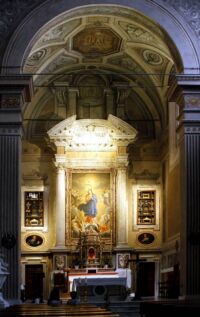 You may know that the Capuchins are a religious order in the Franciscan tradition. They get their name from the hoods they wear which make them look a bit like Jedi Masters.
You may know that the Capuchins are a religious order in the Franciscan tradition. They get their name from the hoods they wear which make them look a bit like Jedi Masters.
In Italian, the name of their brown hood is “cappuccino”—not to be confused with the coffee drink of the same name, which got its name because it was the same color as the hood. Which, of course, prompts the perennial question: Which came first, the coffee or the hood?
Anyway, the church is your run-of-the-mill Renaissance masterpiece—they’re a dime a dozen in Rome, but the real surprise comes when you descend to the church’s basement, which is called, with appropriate creepiness, “The Crypt.”
When descending, it becomes apparent that Stephen King is an amateur purveyor of horror in comparison to those Italian Capuchins.
There are approximately 4000 human skeletons in the crypt, most of whose bones have been disconnected from their original moorings within formerly intact human bodies and are now hanging in pieces in decorative arrangements throughout the entire basement. I promise you, I am not making this up.
Get A Tour
Anyone can walk in and take a tour of the Crypt, but you’ll have to make sure to go on an empty stomach. I’m envisioning an enthusiastic tour guide who might try to put a positive spin on this horrific display, blending a little history with the message:
“Hello everybody! We’re about to begin our tour of this lovely burial chamber where some 4000 religious men have found their final resting place. You can just feel the holiness, can’t you? We’ll get to the specifics of the, um, interesting architecture in a minute. First a little history.
“During the 16th century, the religious order that built this church didn’t have a burial plot for its friars so they began to bury their deceased members here in the basement. I know it’s a little gruesome for American sensibilities, and it probably smelled terribly, but it was a different time and culture, and the rules were different back then. Remember, the Italians are descendants of the Romans, who were kind of brutal.
“Anyway, a new government came to power in 1880, and this church was brought to their attention. They were so horrified by the spectacle that they outlawed burials inside churches after that. Can you blame them? To put it bluntly, we have three hundred years’ worth of Capuchins skeletons in this place, and there would have been many more if someone with some common sense hadn’t taken over.
“Theologically, the Capuchins made this crypt into a huge reminder of the vanity of all earthly things, and what better way to do that than to have a bunch of skeletons looking down on you from every corner of this infernal…uh, I mean internal…chamber, right?”
That’s at least the basic story of the place and how I envision a tour guide trying to make sense of it. It really is one of those things that has to be seen to be believed. (Below are two crypt chapels that contain bones.)
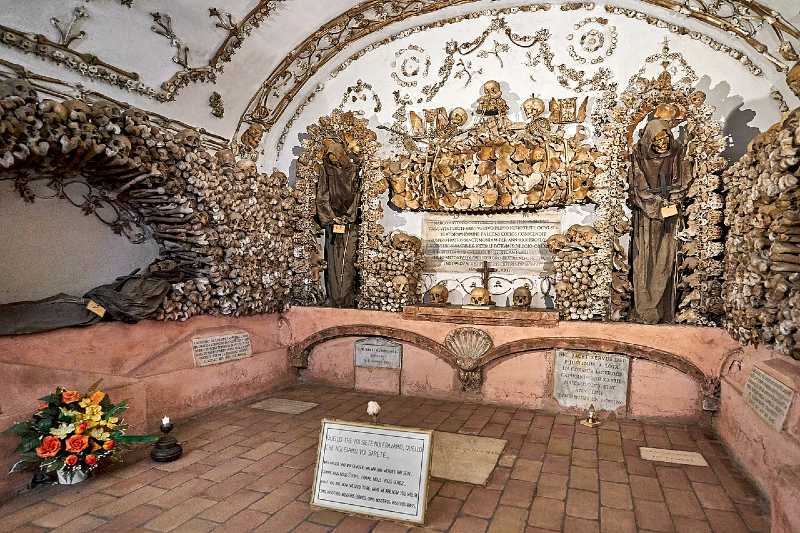
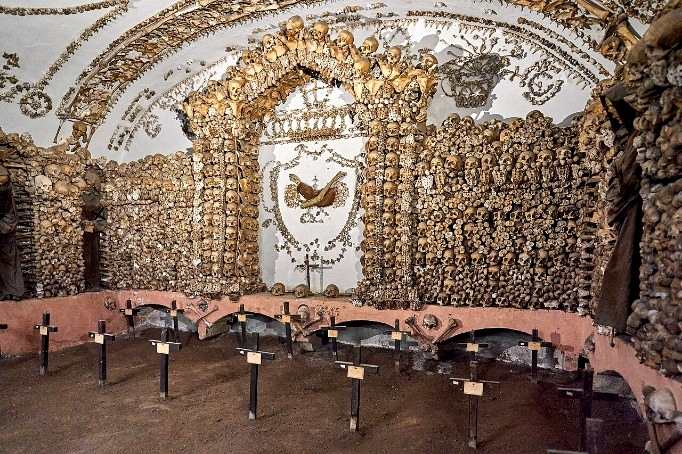
The chapel on the right contains actual burial plots where the bodies lie for 30 years before they are dug up and made part of the displays.
The Message
When I did my own internet search, I was reminded of a time years ago when I actually did see that Bone Crypt myself. What memories!
I vividly recall entering one of the six chapels in the basement where they have placed a skeleton upright in front of a pile of skulls that serves as a backdrop. The skeleton is dressed in a Capuchin robe and holds a sign in his hands that says,
“What you are now, we once were; what we are now, you shall be.”
That gets the message across pretty effectively, does it not? Round about you can find the same phrase in several different languages so that all visitors will be able to read the message…and think of the afterlife, of course.
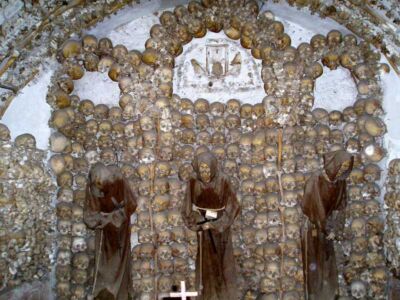 When I got closer and looked into the skeleton’s funereal face, I felt as though I was staring down the Grim Reaper. Upon closer inspection, his jawbone and teeth were fixed with wire to create a kind of morbid grin, as if he were mocking anyone who would dare dispute with him on that basic point of faith.
When I got closer and looked into the skeleton’s funereal face, I felt as though I was staring down the Grim Reaper. Upon closer inspection, his jawbone and teeth were fixed with wire to create a kind of morbid grin, as if he were mocking anyone who would dare dispute with him on that basic point of faith.
I will admit that old Friar Frighticus accomplished the purposes for which the Capuchins set him up several centuries ago. I wonder if they change his habit every hundred years or so, but I digress.
(Image: three ghostly companions)
Such an effective display of otherworldly realism did in fact force me to call to mind the Four Last Things and to think about where I might spend the rest of eternity. That haunting phrase ran through my mind like a ghostly chant:
‘What you are now, we once were; what we are now, you shall be.’
But as I stood there examining the ominous display, I thought about this Pater Horrificus standing before me, and I said under my breath: “Hey buddy, I’m not gonna ‘be like you’ until I know exactly where you went.”
That’s kind of the whole point of the matter, isn’t it? There are only three possibilities for the afterlife: Heaven, Purgatory, or Hell. I’m good with the first two.
Various Chapels
Now imagine what America’s greatest humorist, Mark Twain might say if he were to visit a scene like this. Well, in fact, we don’t have to imagine because he did visit this very Crypt in 1867 and wrote about it in his 1869 book, Innocents Abroad, which is one of the most delightful books I’ve ever read.
Here, Twain is recounting the story of the Capuchin friar who gave his group a personal tour of the Crypt:
“The reflection that [the friar] must someday be taken apart like an engine or a clock…and worked up into arches and pyramids and hideous frescoes, did not distress this monk in the least. I thought he even looked as if he were thinking, with complacent vanity, that his own skull would look well on top of the heap and his own ribs add a charm to the frescoes which possibly they lacked at present.”
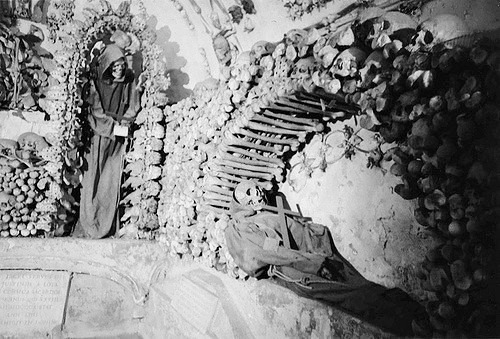
Hilarious! Mark Twain was known for his irreverent humor, but in this case, he probably wasn’t exaggerating. There is enough irony built into the place that all the visitor has to do is to open his eyes. The Crypt contains:
- One whole chapel filled with skulls.
- Another chapel filled with pelvises.
- A third chapel containing only leg and thigh bones.
To add some decorative flourishes to the grim reminders of mortality, the friars got a bit creative:
- The coat of arms of the bishop who commissioned one of the chapels is made entirely of tiny bones and teeth.
- A chandelier made of radius and ulna bones hangs from the ceiling.
- Ribcage sconces decorate the walls, with candleholders made of scapular bones (which are wide enough to hold melted wax so it doesn’t drip onto the floor.)
Given this onslaught of grimness, you really have to wonder when the wholesome spiritual message gets lost in the creepiness of it all.
Not An Isolated Instance
Further research into this phenomenon made me realize that the Bone Church in Rome is not an isolated instance. Numerous chapels around the Catholic world use human bones for decorative reminders of death.
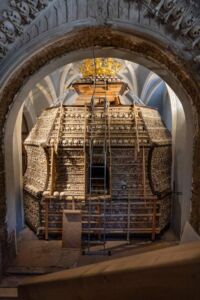 There are bone chapels elsewhere in Italy (of course), Poland, Portugal, and Lima Peru, which are famous for their collections of bones, all decoratively arranged, and all preaching the same general message as the Bone Church in Rome: You’re gonna look like this too someday—you’d better prepare.
There are bone chapels elsewhere in Italy (of course), Poland, Portugal, and Lima Peru, which are famous for their collections of bones, all decoratively arranged, and all preaching the same general message as the Bone Church in Rome: You’re gonna look like this too someday—you’d better prepare.
(At left: I have no idea what it is, but it’s all bones.)
The granddaddy of them all, however, is the Sedlec Ossuary in the Czech Republic, and it would make an Aztec Emperor proud.
The story goes that a Cistercian monk supposedly visited the Holy Land in 1278 AD and brought back a jar of soil from Golgotha. Soon people wanted to be buried next to it, which in turn launched an 800-year trend.
The community claims to have amassed over 40,000 skeletons since then (it could be as high as 70,000, but who can keep track of all those bones for 8 centuries?) My lawyer tells me they all signed consent forms.
Memento Mori (Latin: Reminder of Death)
The Church has a long history of doing the hard work of the Christian life—of reminding people of the passing nature of this world and the reality of judgment in the world to come. It’s not a happy message, but it’s an essential one.
 What the Church does every year on All Souls day is not only to pray for “those who have gone before us marked with the sign of faith,” but also to remind ourselves of the need to prepare for death so that we can endure our final judgment and reunite with our loved ones in the life of the blessed after being purified of all our sins in Purgatory.
What the Church does every year on All Souls day is not only to pray for “those who have gone before us marked with the sign of faith,” but also to remind ourselves of the need to prepare for death so that we can endure our final judgment and reunite with our loved ones in the life of the blessed after being purified of all our sins in Purgatory.
If you ever make a trip to Rome, make sure to visit the Bone Church on Via Veneto where it’s All Souls Day all year round. There you’ll find at least four thousand reminders of that salutary message, albeit in somewhat gruesome garb.
—–
Via Wikimedia: Catherine of Siena head (Giovanni Cerretani); Maria Immacolata Church (José Luiz Bernardes Ribeiro); Anil Öztas (Cemetery and Two Friars); Pater Horrificus with Companions (Tessier~commonswiki); Sedlek Ossuary (shrine website); Twain Source: Innocents Abroad, Chapter 28 via Wikipedia.
———-
[Note: This article is a reproduction of the Sacred Windows Email Newsletter of 11/2/25. Please visit our Newsletter Archives.]
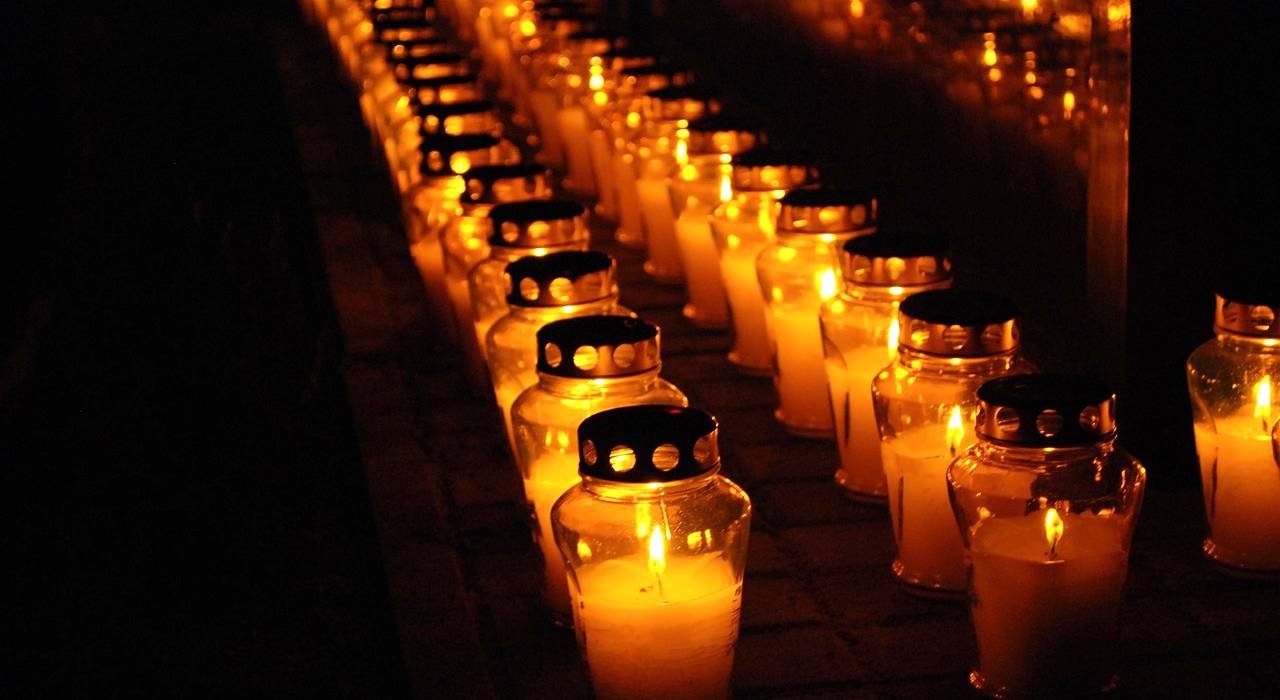
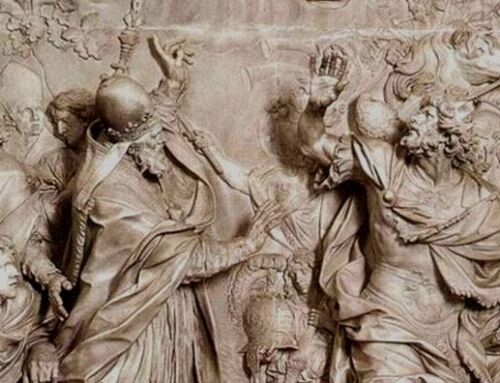
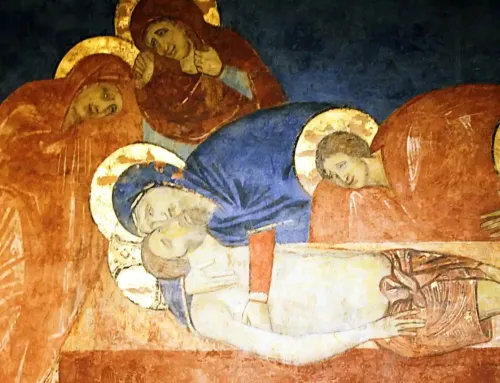
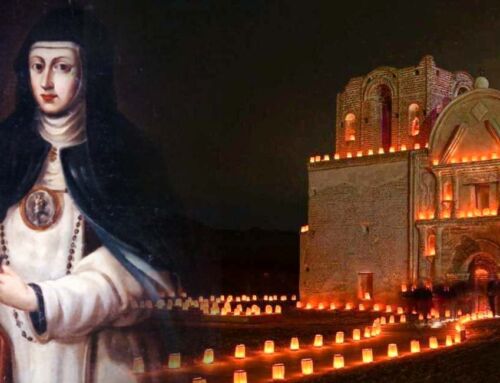
Leave A Comment